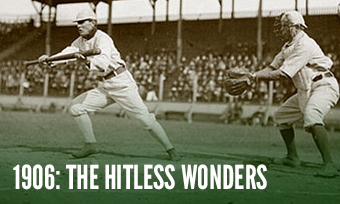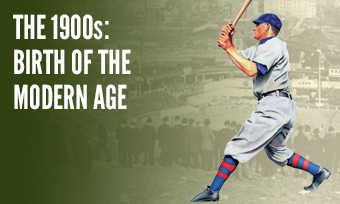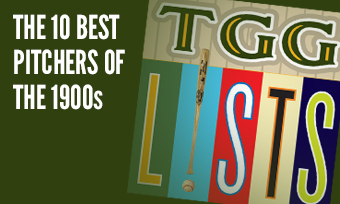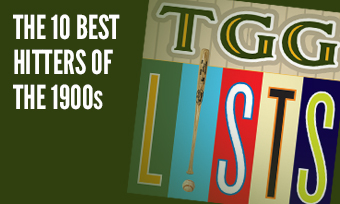The Yearly Reader
Leaders and Honors, 1906
Our list of baseball’s top 10 hitters and pitchers in both the American League and National League for the 1906 baseball season, as well as the awards and honors given to the game’s top achievers of the year.
The National League’s Top 10 Hitters, 1906
Bold type in brick red indicates league leader.
1. Honus Wagner, Pittsburgh
Key Numbers: .339 average, 103 runs, 38 doubles, 71 RBIs, 53 stolen bases.
Without Wagner, the Pirates as a team hit .252—or nearly 90 points below the Flying Dutchman’s season figure.
2. Frank Chance, Chicago
Key Numbers: .319 average, 103 runs, 10 triples, 71 RBIs, 70 walks, 57 stolen bases.
Never to be confused for an iron man due to his dual role as manager—and his unfortunate penchant for getting hit in the noggin—Chance logged the most games (136) of his career while piloting the Cubs to a NL-record 116 victories.
3. Harry Steinfeldt, Chicago
Key Numbers: .327 average, 91 runs, 176 hits, 10 triples, 83 RBIs.
After eight years in Cincinnati, there was no trouble with Harry as he moved to Chicago and forged an anomalous season—hitting 60 points over his career average.
4. Harry Lumley, Brooklyn
Key Numbers: .324 average, 12 triples, 9 home runs, 61 RBIs, 35 stolen bases.
Only nine players hit 10 or more homers in a NL season during the 1900s, but Lumley once again came oh-so-close—hitting nine for one of three times in his career.
5. Art Devlin, New York
Key Numbers: .299 average, 74 walks, 2 home runs, 65 RBIs, 54 stolen bases.
It was a banner year for the young third baseman—setting career highs in batting average, doubles and walks, while tying the knot with a Chicago woman with family money.
6. Sherry Magee, Philadelphia
Key Numbers: .282 average, 36 doubles, 6 home runs, 67 RBIs, 55 stolen bases.
Magee’s 55 steals would be the most by a Phillie until Juan Samuel topped him nearly 78 years later.
7. Tim Jordan, Brooklyn
Key Numbers: .262 average, 12 home runs, 78 RBIs, 59 walks.
After a number of years trying to escape the minors, Jordan finally found major league bliss in his hometown and won the first of two NL home run titles—something no other Dodger has ever done.
8. Cy Seymour, Cincinnati-New York
Key Numbers: .286 average, 8 home runs, 80 RBIs.
The man second only to Babe Ruth in a combination of pitching wins and base hits, Seymour rallied in New York (.320) after being traded from the Reds (.257) at midseason.
9. Roger Bresnahan, New York
Key Numbers: .281 average, 81 walks, 15 hit-by-pitches, .419 on-base percentage.
The gifted catcher turned a somewhat innocuous batting average into a NL-high on-base percentage through a plethora of walks and hit-by-pitches.
10. Miller Huggins, Cincinnati
Key Numbers: .292 average, 81 runs, 71 walks, 41 stolen bases.
One of the stronger season performances for the future Yankees manager.
The American League’s Top 10 Hitters, 1906
1. George Stone, St. Louis
Key Numbers: .358 average, 91 runs, 208 hits, 20 triples, 6 home runs, 71 RBIs, 35 stolen bases.
The second-year Stone—still giving the Boston Americans (Red Sox) hangovers for letting him go in an ill-advised trade—won the sabermetricians’ triple crown, pacing the AL in batting average, on-base percentage and slugging percentage.
2. Nap Lajoie, Cleveland
Key Numbers: .355 average, 88 runs, 214 hits, 48 doubles, 91 RBIs.
Back at full strength following a season-ending injury the previous July, Lajoie muscled up for another Hall of Fame-caliber campaign…all without hitting a single home run.
3. Harry Davis, Philadelphia
Key Numbers: .292 average, 94 runs, 42 doubles, 12 home runs, 96 RBIs.
Although Davis set a career high with 12 homers—and led the AL for the third of four straight years—he never knocked in more than 100 runs in a season. He came closest in 1906.
4. Elmer Flick, Cleveland
Key Numbers: .311 average, 98 runs, 194 hits, 34 doubles, 22 triples, 39 stolen bases.
A busy year for the veteran star outfielder, who played every one of 157 games for the Naps while setting a personal best with 22 triples.
5. Hal Chase, New York
Key Numbers: .323 average, 84 runs, 193 hits, 76 RBIs.
After learning the ropes as a 1905 rookie, future game-fixer Chase put up some of the best numbers he would see for a decade; perhaps integrity had something to do with it.
6. Charlie Hemphill, St. Louis
Key Numbers: .289 average, 90 runs, 4 home runs, 62 RBIs, 33 stolen bases.
The closest thing to a complement for George Stone (above), Hemphill had arguably his best year yet—certainly better than younger brother Frank, who was a hitless blunder (3-for-40) among the White Sox’ hitless wonders.
7. Sam Crawford, Detroit
Key Numbers: .295 average, 25 doubles, 16 triples, 72 RBIs.
After a relatively few quiet years, Crawford began to crank it back up; the emergence of teammate Ty Cobb likely had something to do with it.
8. George Davis, Chicago
Key Numbers: .277 average, 26 doubles, 80 RBIs.
The 36-year-old shortstop transcended the White Sox’ “Hitless Wonders” brand and played strong enough offense to be the only member of the Pale Hose to make this list.
9. Terry Turner, Cleveland
Key Numbers: .291 average, 85 runs, 170 hits.
Turner, whose long tenure at Cleveland spanned the entire Deadball Era (1901-19), was never better than in 1906.
10. Bobby Wallace, St. Louis
Key Numbers: .258 average, 67 RBIs, 58 walks, 24 stolen bases.
The future Hall of Famer—why he’s in, we really don’t know—quietly had one of his better years.
The National League’s Top 10 Pitchers, 1906
1. Three Finger Brown, Chicago
Key Numbers: 1.04 ERA, 26 wins, 6 losses, .813 win percentage, 277.1 innings.
The disfigured pitcher’s remarkable breakout campaign included an ERA that’s the lowest in modern NL history.
2. Tully Sparks, Philadelphia
Key Numbers: 2.16 ERA, 19 wins, 16 losses, 316.2 innings.
Workhorse for a year, Sparks nearly managed 20 wins despite offensive support that was nearly half of what he got in 1905.
3. Vic Willis, Pittsburgh
Key Numbers: 1.73 ERA, 23 wins, 13 losses, 322 innings.
Unshackled from the NL basement in Boston, Willis went from an unsupported 20-game loser for the Beaneaters to a well-supported 20-game winner at Pittsburgh.
4. Jack Pfiester, Chicago
Key Numbers: 1.51 ERA, 20 wins, 8 losses, 250.2 innings.
The 28-year-old southpaw entered the season with one career major league win and finished it as one of two 20-win pitchers for the 116-36 Cubs.
5. Joe McGinnity, New York
Key Numbers: 2.25 ERA, 27 wins, 12 losses, 45 appearances, 339.2 innings.
As Christy Mathewson struggled with an early-season illness, McGinnity reclaimed the role of Giants ace and led the NL for the fifth (and last) time in wins.
6. Ed Reulbach, Chicago
Key Numbers: 1.65 ERA, 19 wins, 4 losses, .826 win percentage.
Nobody was tougher to hit off in the majors—Three Finger Brown included—than Reulbach, who allowed a .175 batting average.
7. Jack Taylor, St. Louis-Chicago
Key Numbers: 1.99 ERA, 20 wins, 12 losses, 302.1 innings.
All seemed forgiven in Chicago for Taylor, traded back to the Cubs after being accused of throwing games during his last stay there.
8. Lefty Leifield, Pittsburgh
Key Numbers: 1.87 ERA, 18 wins, 13 losses.
Strong debut for the southpaw from Illinois whose ERA would be the lowest of his 12-year career.
9. Sam Leever, Pittsburgh
Key Numbers: 2.32 ERA, 22 wins, 7 losses, 260.1 innings.
The fourth and final 20-win campaign for Leever wrapped a six-year run in which he won 114 games and lost just 42.
10. Jake Weimer, Chicago
Key Numbers: 2.22 ERA, 20 wins, 14 losses, 304.2 innings.
Jake could have been a contender, but the Cubs shipped him off to lowly Cincinnati (for Harry Steinfeldt); still, he responded with his third season of exactly 20 wins over a four-year stretch.
The American League’s Top 10 Pitchers, 1906
1. Addie Joss, Cleveland
Key Numbers: 1.72 ERA, 21 wins, 9 losses, 282 innings.
The steady ascension from solid pitcher to top ace continued for Joss, who scored 20 wins with a sub-2.00 ERA in the same season for the first time.
2. Bob Rhoads, Cleveland
Key Numbers: 1.80 ERA, 22 wins, 10 losses, 315 innings.
It could be argued that Rhoads’ campaign was better than that of teammate Joss—and if anyone ever won 20 games while collecting more walks (92) than strikeouts (89), we have yet to know about it.
3. Otto Hess, Cleveland
Key Numbers: 1.83 ERA, 20 wins, 17 losses, 333.2 innings.
Wrapping up the triumvirate of 20-game winners at Cleveland, the Swiss-born Otto Hess enjoyed his wonder season amid an otherwise neutral career.
4. Ed Walsh, Chicago
Key Numbers: 1.88 ERA, 17 wins, 13 losses, 10 shutouts, 278.1 innings.
No White Sox pitcher understood the importance of being at their best while getting low run support than the emerging Walsh, who threw 10 shutouts among his 17 wins for the Hitless Wonders.
5. Barney Pelty, St. Louis
Key Numbers: 1.59 ERA, 16 wins, 11 losses, 260.2 innings.
Nicknamed the Yiddish Curver for his Jewish upbringing, Pelty had his finest season in an otherwise uninspiring career.
6. Al Orth, New York
Key Numbers: 2.34 ERA, 27 wins, 17 losses, 338.2 innings.
After laboring for some truly awful Washington teams, Orth received long-overdue support—and thus recognition.
7. Nick Altrock, Chicago
Key Numbers: 2.06 ERA, 20 wins, 13 losses, 287.2 innings.
Altrock was able to make it two straight 20-win seasons thanks to a victory in which he didn’t throw a single pitch—picking off a runner for the third out of the ninth just after being brought into the game as a reliever.
8. Jack Powell, St. Louis
Key Numbers: 1.77 ERA, 13 wins, 14 losses.
Being given 2.48 runs of support per start will always make it tough to sport a winning record even with an ERA as good as Powell’s.
9. Jack Chesbro, New York
Key Numbers: 2.96 ERA, 23 wins, 17 losses, 49 appearances, 42 starts, 325 innings.
The fading Chesbro did well in an attempt to emulate his superhuman effort of two years earlier.
10. Frank Owen, Chicago
Key Numbers: 2.33 ERA, 22 wins, 13 losses, 293 innings.
Owen’s brief reign as a top White Sox pitcher hit its coda as he won 20-plus games for the third straight year; he notched only nine more victories in the following three seasons before exiting the majors for good, all before turning 30.









